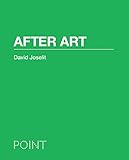After Art / David Joselit.
Material type: TextSeries: POINT: Essays on Architecture ; 2Publisher: Princeton, NJ : Princeton University Press, [2012]Copyright date: ©2013Description: 1 online resource (136 p.) : 39 color illus. 1 halftoneContent type:
TextSeries: POINT: Essays on Architecture ; 2Publisher: Princeton, NJ : Princeton University Press, [2012]Copyright date: ©2013Description: 1 online resource (136 p.) : 39 color illus. 1 halftoneContent type: - 9780691150444
- 9781400845149
- Art and society
- Art -- Psychology
- ART / Criticism
- Acropolis Museum
- Ai Weiwei
- Alejandro Zaera-Polo
- Alexander Nemerov
- Andy Warhol
- Antonio Negri
- Art Basel
- Art history
- Art museum
- Art world
- Arthur Danto
- Bernard Tschumi
- Bill Ayers
- Boris Groys
- Bruno Latour
- Calculation
- Capitalism
- Clement Greenberg
- Commodity
- Conceptual art
- Contemporary art
- Creative Commons
- Cultural Property (Japan)
- Cultural capital
- Curator
- Customer
- Damien Hirst
- De Stijl
- Decolonization
- Diagram
- Digital photography
- Dissemination
- Electronic Disturbance Theater
- Emblem
- Epistemology
- Financial capital
- Frank Gehry
- Globalization
- Guggenheim Museum Bilbao
- Hannah Arendt
- Hans Belting
- High culture
- Iconology
- Ideology
- Illegal immigration
- Income
- Infrastructure
- Instance (computer science)
- Institution
- Institutional Critique
- Kunsthalle Wien
- Lawrence Lessig
- Le Corbusier
- MIT Press
- Manifesto
- Market economy
- Matthew Barney
- Michael Hardt
- Michel Foucault
- Modern architecture
- Modernism
- Museum
- Narrative
- Neoliberalism
- Newspaper
- Overproduction
- Ownership
- Oxford University Press
- Parametricism
- Photography
- Postcard
- Public sphere
- Publication
- Rachel Harrison
- Rem Koolhaas
- Repatriation (humans)
- Rhetoric
- Richard Meier
- Rirkrit Tiravanija
- Rosalind E. Krauss
- Roselee Goldberg
- Saskia Sassen
- Scalability
- Sherrie Levine
- Social space
- Subodh Gupta
- Surrealism
- T. J. Clark (art historian)
- Tactical media
- Tania Bruguera
- The Society of the Spectacle
- Tourism
- Understanding
- Venice Biennale
- Visual culture
- Walker Evans
- Walter Benjamin
- Wealth
- Website
- Work of art
- 701 23
- N71 .J68 2013
- online - DeGruyter
| Item type | Current library | Call number | URL | Status | Notes | Barcode | |
|---|---|---|---|---|---|---|---|
 eBook
eBook
|
Biblioteca "Angelicum" Pont. Univ. S.Tommaso d'Aquino Nuvola online | online - DeGruyter (Browse shelf(Opens below)) | Online access | Not for loan (Accesso limitato) | Accesso per gli utenti autorizzati / Access for authorized users | (dgr)9781400845149 |
Browsing Biblioteca "Angelicum" Pont. Univ. S.Tommaso d'Aquino shelves, Shelving location: Nuvola online Close shelf browser (Hides shelf browser)

|

|

|

|

|

|

|
||
| online - DeGruyter Camille Saint-Saëns and His World / | online - DeGruyter Mozart's Grace / | online - DeGruyter Fellow Men : Fantin-Latour and the Problem of the Group in Nineteenth-Century French Painting / | online - DeGruyter After Art / | online - DeGruyter Heart Beats : Everyday Life and the Memorized Poem / | online - DeGruyter Morgantina Studies, Volume VI : The Hellenistic and Roman Fine Pottery / | online - DeGruyter Warriors of the Cloisters : The Central Asian Origins of Science in the Medieval World / |
Frontmatter -- Contents -- Acknowledgments -- Preface -- Image Explosion -- Populations -- Formats -- Power -- Notes -- Credits -- POINT: Essays on Architecture
restricted access online access with authorization star
http://purl.org/coar/access_right/c_16ec
Art as we know it is dramatically changing, but popular and critical responses lag behind. In this trenchant illustrated essay, David Joselit describes how art and architecture are being transformed in the age of Google. Under the dual pressures of digital technology, which allows images to be reformatted and disseminated effortlessly, and the exponential acceleration of cultural exchange enabled by globalization, artists and architects are emphasizing networks as never before. Some of the most interesting contemporary work in both fields is now based on visualizing patterns of dissemination after objects and structures are produced, and after they enter into, and even establish, diverse networks. Behaving like human search engines, artists and architects sort, capture, and reformat existing content. Works of art crystallize out of populations of images, and buildings emerge out of the dynamics of the circulation patterns they will house. Examining the work of architectural firms such as OMA, Reiser + Umemoto, and Foreign Office, as well as the art of Matthew Barney, Ai Weiwei, Sherrie Levine, and many others, After Art provides a compelling and original theory of art and architecture in the age of global networks.
Mode of access: Internet via World Wide Web.
In English.
Description based on online resource; title from PDF title page (publisher's Web site, viewed 27. Jan 2023)


